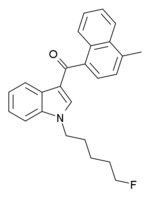MAM-2201
MAM-2201 (4'-methyl-AM-2201, 5"-fluoro-JWH-122) is a drug that presumably acts as a potent agonist for the cannabinoid receptors.[1][2] It had never previously been reported in the scientific or patent literature, and was first identified by laboratories in the Netherlands and Germany in June 2011 as an ingredient in synthetic cannabis smoking blends.[3][4][5] Like RCS-4 and AB-001, MAM-2201 thus appears to be a novel compound invented by "research chemical" suppliers specifically for grey-market recreational use. Structurally, MAM-2201 is a hybrid of two known cannabinoid compounds JWH-122 and AM-2201, both of which had previously been used as active ingredients in synthetic cannabis blends before being banned in many countries.
 | |
| Legal status | |
|---|---|
| Legal status |
|
| Identifiers | |
IUPAC name
| |
| CAS Number | |
| PubChem CID | |
| ChemSpider | |
| CompTox Dashboard (EPA) | |
| ECHA InfoCard | 100.257.545 |
| Chemical and physical data | |
| Formula | C25H24FNO |
| Molar mass | 373.471 g·mol−1 |
| 3D model (JSmol) | |
SMILES
| |
InChI
| |
A study of MAM-2201 in rats showed that it causes neurofunctional disruptions.[6]
Legal status
In the United States, all CB1 receptor agonists of the 3-(1-naphthoyl)indole class such as MAM-2201 are Schedule I Controlled Substances.[7]
MAM-2201 has been banned by being added to the temporary class drug schedule in New Zealand, effective from 13 July 2012.[8]
As of October 2015 MAM-2201 is a controlled substance in China.[9]
References
- Kei Zaitsu; Hiroshi Nakayama; Mayumi Yamanaka; Kazuaki Hisatsune; Kentaro Taki; Tomomi Asano; Tooru Kamata; Munehiro Katagai; Yumi Hayashi; Maiko Kusano; Hitoshi Tsuchihashi; Akira Ishii (November 2015). "High-resolution mass spectrometric determination of the synthetic cannabinoids MAM-2201, AM-2201, AM-2232, and their metabolites in postmortem plasma and urine by LC/Q-TOFMS". International Journal of Legal Medicine. 129 (6): 1233–1245. doi:10.1007/s00414-015-1257-4. PMID 26349566.
- Kim, Ju-Hyun; Kong, Tae Yeon; Moon, Ju-Yeon; Choi, Kyung Ho; Cho, Yong-Yeon; Kang, Han Chang; Lee, Joo Young; Lee, Hye Suk (2018). "Targeted and non-targeted metabolite identification of MAM-2201 in human, mouse, and rat hepatocytes". Drug Testing and Analysis. 10 (8): 1328–1335. doi:10.1002/dta.2389. ISSN 1942-7611. PMID 29608249.
- EMCDDA–Europol 2011 Annual Report on the implementation of Council Decision 2005/387/JHA
- Moosmann, B.; et al. (2012). "Separation and structural characterization of the synthetic cannabinoids JWH-412 and 1-(5-fluoropentyl)-1H-indol-3yl]-(4-methylnaphthalen-1-yl)methanone using GC–MS, NMR analysis and a flash chromatography system". Forensic Science International. 220 (1–3): e17–e22. doi:10.1016/j.forsciint.2011.12.010. PMID 22264627.
- Simolka, K.; et al. (2012). "Analysis of synthetic cannabinoids in "spice-like" herbal highs: Snapshot of the German market in summer 2011". Analytical and Bioanalytical Chemistry. 404 (1): 157–171. doi:10.1007/s00216-012-6122-4. PMID 22710567.
- Zaitsu, K; Hayashi, Y; Suzuki, K; Nakayama, H; Hattori, N; Takahara, R; Kusano, M; Tsuchihashi, H; Ishi, A (2015). "Metabolome disruption of the rat cerebrum induced by the acute toxic effects of the synthetic cannabinoid MAM-2201". Life Sciences. 137: 49–55. doi:10.1016/j.lfs.2015.05.013. PMID 26032255.
- : Schedules of controlled substances
- Temporary Class Drug Notice, 5 July 2012. NZ Department of Internal Affairs.
- "关于印发《非药用类麻醉药品和精神药品列管办法》的通知" (in Chinese). China Food and Drug Administration. 27 September 2015. Retrieved 1 October 2015.